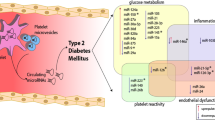Abstract
Aims
MicroRNA-103 (miR-103) plays a critical role in regulating glucose homeostasis in type 2 diabetes (DM2). Recent data suggest that secreted frizzled-related protein 4 (SFRP4) serves as a potential risk biomarker for prediabetic mellitus (pre-DM) and that platelets are enriched for miR-103. The objective of this study was to test the hypothesis that platelet-derived miR-103b (miR-103-as), which regulates SFRP4, might be a novel biomarker for the early diagnosis of DM2.
Methods
We evaluated platelet miR-103b expression in healthy subjects (n = 46), pre-DM subjects (n = 48), non-complicated diabetic subjects (n = 43) and diabetes mellitus type 2–coronary heart disease subjects (n = 36), respectively, and analyzed the relationship of these levels with its target gene SFRP4.
Results
In qRT-PCR assays, miR-103b were significantly down-regulated, and conversely, the expression of the SFRP4 gene was up-regulated in pooled leukocyte-depleted platelets and individual subjects with pre-DM. Additionally, patients who had undergone antiplatelet treatment were characterized by decreased gene expression of SFRP4 and increased levels of platelet-derived miR-103b. miR-103b modulated reporter gene expression through SFRP4 mRNA 3′-UTR seed sequence and negatively regulated its expression. Furthermore, SFRP4 mRNA and protein levels were down-regulated by a miR-103b mimic but were up-regulated by a miR-103b inhibitor.
Conclusions
The results suggest that platelet-derived miR-103b could negatively regulate the expression of SFRP4 mRNA/protein in pre-DM2, indicating that miR-103b could be a novel biomarker for the early diagnosis of DM2.




Similar content being viewed by others
References
Liddy CE, Cullen-Arseneau P, Merizzi S, Blazhko V (2013) An ounce of prevention: a primary care based prevention program for pre-diabetic population. Can J Diabetes 37:12–17
Nazaribadie M, Asgari K, Amini M, Ahmadpanah M, Nazaribadie M, Jamlipaghale S (2013) Cognitive processes and functions in patients with type 2 diabetes in comparison to pre-diabetic patients. J Res Health Sci 13:208–213
Mahdi T, Hanzelmann S, Salehi A, Muhammed SJ, Reinbothe TM, Tang Y, Axelsson AS, Zhou Y, Jing X, Almgren P, Krus U, Taneera J, Blom AM, Lyssenko V, Esguerra JL, Hansson O, Eliasson L, Derry J, Zhang E, Wollheim CB, Groop L, Renström E, Rosengren AH (2012) Secreted frizzled-related protein 4 reduces insulin secretion and is overexpressed in type 2 diabetes. Cell Metab 16:625–633
Yang Z, Chen H, Si H, Li X, Ding X, Sheng Q, Chen P, Zhang H (2014) Serum miR-23a, a potential biomarker for diagnosis of pre-diabetes and type 2 diabetes. Acta Diabetol 51:823–831
Ha TY (2011) MicroRNAs in Human Diseases: from cancer to cardiovascular disease. Immune Netw 11:135–154
Creemers EE, Tijsen AJ, Pinto YM (2012) Circulating microRNAs: novel biomarkers and extracellular communicators in cardiovascular disease? Circ Res 110:483–495
Bronze-da-Rocha E (2014) MicroRNAs expression profiles in cardiovascular diseases. Biomed Res Int 2014:985408
Landry P, Plante I, Ouellet DL, Perron MP, Rousseau G, Provost P (2009) Existence of a microRNA pathway in anucleate platelets. Nat Struct Mol Biol 16:961–966
Edelstein LC, Bray PF (2011) MicroRNAs in platelet production and activation. Blood 117:5289–5296
Ple H, Landry P, Benham A, Coarfa C, Gunaratne PH, Provost P (2012) The repertoire and features of human platelet microRNAs. PLoS One 7:e50746
Willeit P, Zampetaki A, Dudek K, Kaudewitz D, King A, Kirkby NS, Crosby-Nwaobi R, Prokopi M, Drozdov I, Langley SR, Sivaprasad S, Markus HS, Mitchell JA, Warner TD, Kiechl S, Mayr M (2013) Circulating microRNAs as novel biomarkers for platelet activation. Circ Res 112:595–600
Trajkovski M, Hausser J, Soutschek J, Bhat B, Akin A, Zavolan M, Heim MH, Stoffel M (2011) MicroRNAs 103 and 107 regulate insulin sensitivity. Nature 474:649–653
Lewis BP, Burge CB, Bartel DP (2005) Conserved seed pairing, often flanked by adenosines, indicates that thousands of human genes are microRNA targets. Cell 120:15–20
John B, Enright AJ, Aravin A, Tuschl T, Sander C, Marks DS (2004) Human MicroRNA targets. PLoS Biol 2:e363
Wang X (2008) miRDB: a microRNA target prediction and functional annotation database with a wiki interface. RNA 14:1012–1017
Dweep H, Sticht C, Pandey P, Gretz N (2011) miRWalk–database: prediction of possible miRNA binding sites by “walking” the genes of three genomes. J Biomed Inform 44:839–847
Nagalla S, Shaw C, Kong X, Kondkar AA, Edelstein LC, Ma L, Chen J, McKnight GS, López JA, Yang L, Jin Y, Bray MS, Leal SM, Dong JF, Bray PF (2011) Platelet microRNA-mRNA coexpression profiles correlate with platelet reactivity. Blood 117:5189–5197
Livak KJ, Schmittgen TD (2001) Analysis of relative gene expression data using real-time quantitative PCR and the 2(-Delta Delta C(T)) method. Methods 25:402–408
Markham NR, Zuker M (2008) UNAFold: software for nucleic acid folding and hybridization. Methods Mol Biol 453:3–31
Acknowledgments
This work was supported by the AHA National Scientist Development Grant (10SDG2570DG037), the National Natural Science Foundation of China (81172050), Foundation of the Sichuan Education of China (11ZB123), Foundation of the Health Department of Sichuan Province (120371), and Foundation of Luzhou Municipal Science and Technology Bureau (2013-S-47, 2013LZLY-K64).
Conflict of interest
All the authors including Mao Luo, Rong Li, Xin Deng, Meiping Ren, Ni Chen, Min Zeng, Kai Yan, Jiyi Xia, Fei Liu, Weizhong Ma, Yan Yang, Qin Wan, and Jianbo Wu declare that they have no conflict of interest.
Ethical approval
All procedures followed were in accordance with the ethical standards of the responsible committee on human experimentation (institutional and national) and with the Declaration of Helsinki 1975, as revised in 2008 (5).
Informed consent
Informed consent was obtained from all patients for being included in the study.
Author information
Authors and Affiliations
Corresponding authors
Additional information
Managed by Massimo Porta.
Electronic supplementary material
Below is the link to the electronic supplementary material.
Rights and permissions
About this article
Cite this article
Luo, M., Li, R., Deng, X. et al. Platelet-derived miR-103b as a novel biomarker for the early diagnosis of type 2 diabetes. Acta Diabetol 52, 943–949 (2015). https://doi.org/10.1007/s00592-015-0733-0
Received:
Accepted:
Published:
Issue Date:
DOI: https://doi.org/10.1007/s00592-015-0733-0




